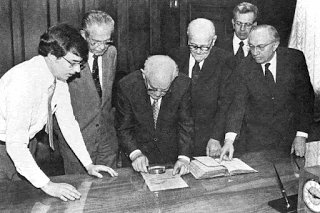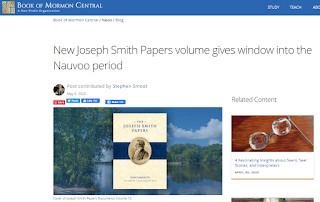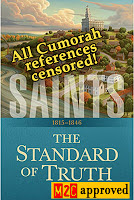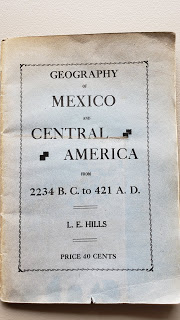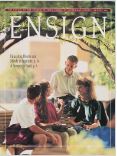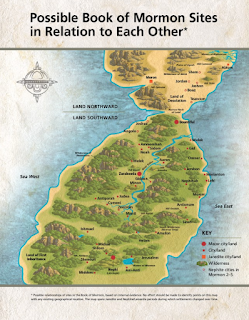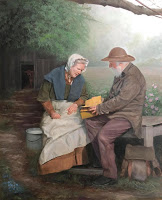M2C and the Hoffman saga
Readers ask me all the time how M2C persists. It requires a lot of bias confirmation. I recently posted another comment about volcanoes in Mesoamerica to illustrate the power of bias confirmation, compounded by faulty assumptions. You can read it here.
http://interpreterpeerreviews.blogspot.com/2020/05/m2c-volcanoes-bias-confirmation-and.html
In that post, I compared the M2C problem to the parable of the wheat and the tares. One reason why I encourage M2C readers not to read this blog is because so many faithful LDS have their testimonies entwined with M2C.
Book of Mormon Central and the rest of the M2C citation cartel are spending millions of dollars to portray M2C as the only valid interpretation of the Book of Mormon.
I don’t want people to discard their faith just because they come to the realization that M2C (i) repudiates the teachings of the prophets about Cumorah and (ii) is based on logical and factual fallacies. We don’t want to “pluck up” M2C if it will damage tender faith.
People who read only M2C material never learn that there is an alternative interpretation of the Book of Mormon and the relevant sciences that corroborates and supports, instead of contradicts and repudiates, the teachings of the prophets about Cumorah.
That’s why I wish Book of Mormon Central was neutral, pursuant to the Church’s position.
It’s why I keep emphasizing that people should not think “M2C or bust.” M2C ≠ truth.
_____
Back to the comparison between Mark Hoffman and M2C.
 |
| Mark Hoffman sharing forged document with First Presidency and members of the Twelve |
Mark Hoffman was a well-known collector of Mormon documents. In the 1980s, he sold several to the Church. Experts, including Church historians, examined the documents and pronounced them authentic. They persuaded Church leaders that the documents were authentic.
The Church even purchased some of the forged documents.
After Hoffman murdered two people with bombs, and injured himself, investigators discovered that he had forged hundreds of documents, including the ones the Church purchased. There are books, articles, and even a documentary about the whole thing.
After investigators proved the documents were forged and charges were filed against Hoffman, investigators went to BYU to speak with those who had validated the documents.
By then, these historians had written articles based on the forgeries. The most notorious forgery was the Salamander letter, purportedly written by Martin Harris to W.W. Phelps, that claimed it was a salamander, not Moroni, who appeared to Joseph Smith.
Apologists such as FARMS had figured out a way to explain how the Salamander letter was consistent with what Joseph had taught all along. One of their publications was titled “Why Might a Person in 1830 Connect and Angel with a Salamander?”
In reality, Hoffman had derived the letter from the 1834 anti-Mormon book Mormonism Unvailed, which has recently enjoyed a renaissance of popularity among Church historians, as we’ve discussed before.
Back to the BYU visit. The investigators met with the historians, “none of whom seemed to think the prosecutors had a case… the only difference between LDS historians and Mormon religion teachers was that the historians still sounded like defense witnesses while the religion instructors pointed out anachronisms and other problems in the Hoffmann documents.” (Linda Sillitoe and Allen Roberts, Salamander: The Story of the Mormon Forgery Murders (Signature Books, 2006): 171-2).
_____
By now, I’m sure you see these two points.
1. Church leaders naturally (and necessarily, given time constraints) deferred to trusted experts regarding the authenticity of the forgeries. Church leaders must focus on ministering to people and administering the Church. They have to rely on experts for ancillary matters such as Church history, Book of Mormon historicity, scientific issues, financial issues, logistics, etc. The same is true for ordinary members; we are busy with our own lives and necessarily trust the experts on matters of special expertise.
2. The experts, albeit faithful and qualified, made errors. Fine, that happens. What is fascinating is how quickly a groupthink developed that redefined long-held understandings about Joseph Smith and early Church history. The groupthink caused the experts to stop investigating the documents (until the bombings). Church intellectuals figured out a way to incorporate the forged documents into their own theories about Church history and reinforced their new approach using their citation cartel and the academic cycle. Even when outside investigators proved the documents were forgeries, they resisted reality because their strong bias confirmation had embraced the documents as genuine.
In fact, it can be argued that the influence of the Hoffman forgeries continued through the present in the way Church historians are interpreting Church history (a topic for another day).
Conclusion. Church members and leaders who relied on the experts were misled by faithful, well-meaning experts who, for various reasons, developed a groupthink around the forged documents. Bias confirmation strengthened the groupthink to the point where it could be overcome only by outside experts and irrefutable evidence.
_____
Readers here already see the parallels to M2C.
I think that most M2C intellectuals and their followers are sincere, faithful members of the Church. They have rationalized away their repudiation of the teachings of the prophets about the New York Cumorah (although they are still uncomfortable defending their position).
Like the Hoffman document believers, M2C believers have developed a groupthink, supported by bias confirmation, that prevents them from seeing, let alone considering, alternative interpretations of the text and the relevant sciences.
One simple example is their groupthink about volcanoes; i.e., although Mormon never mentioned volcanoes in 1,000 years of “Mayan” history in Mesoamerica, the M2C believers read volcanoes into the text. They do the same with massive stone pyramids and the three Js: jade, jaguars, and jungles.
Their groupthink is so powerful that they “cannot unsee” Mesoamerica when they read the Book of Mormon.
And, as I always say, that’s perfectly fine. Any groupthink that leads people to Christ through the Book of Mormon is fine with me.
The same could have been said for the Hoffman forgeries, as the FARMS paper showed.
But for most people, the forgeries had a negative impact. While many scholars were disappointed to discover the forgery because they had published and spoken about them, most Church members were relieved to know the documents were fake.
It’s similar with M2C.
Most faithful LDS, ordinary members and leaders alike, who learn only M2C tend to accept it because they think, thanks to the efforts of the M2C promoters, that it is the only explanation for the historicity of the Book of Mormon. These faithful LDS love the Book of Mormon and have testimonies, so they accept M2C as a sort of appendage.
But many faithful LDS have reservations about M2C. They know what the prophets have taught about the New York Cumorah. They know what Joseph said about the “plains of the Nephites” in Ohio, Indiana, and Illinois. They know about Zelph. They read the rationalizations of the M2C scholars but have difficulty accepting them because of logical and factual fallacies.
Some go further and investigate Mayan society and culture. They see the incongruities. They begin to recognize that the “correspondences” cited by M2C scholars are illusory.
If they don’t know there is an alternative to M2C, many of these faithful Church members become confused and disturbed in their faith, as Joseph Fielding Smith warned so long ago.
As for non-members, M2C requires an enormous leap of faith. It’s a bridge too far for most of them, even before they learn that M2C directly repudiates the teachings of the prophets.
It’s a mess.
But it doesn’t have to be.
The teachings of the prophets about the New York Cumorah are so consistent and clear, and the scientific evidence that supports and corroborates those teachings is so abundant, that more and more Church members are recognizing that M2C doesn’t cut it any longer.
That won’t change any minds among M2C scholars, their followers, or their employees. It would require irrefutable evidence akin to the exposure of the Hoffman forgeries to change the minds of the M2C believers.
That’s why this blog doesn’t even try to change anyone’s mind.
All we can do is offer information to let people make their own informed decisions.
As you deal with M2C believers, be patient and understanding. Remember that they have never learned that there is an alternative interpretation of the Book of Mormon and the relevant sciences that corroborates and supports, instead of contradicts and repudiates, the teachings of the prophets about Cumorah.
_____
* Faith Crisis: we were not betrayed, by L. Hannah Stoddard and James E. Stoddard III.
Source: About Central America
